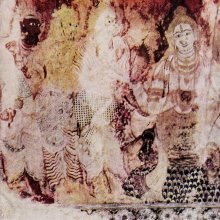It, Īṭ, Īt, Iṭ: 9 definitions
Introduction:
It means something in Hinduism, Sanskrit. If you want to know the exact meaning, history, etymology or English translation of this term then check out the descriptions on this page. Add your comment or reference to a book if you want to contribute to this summary article.
Images (photo gallery)
(+1912 more images available)
In Hinduism
Vyakarana (Sanskrit grammar)
Source: Wikisource: A dictionary of Sanskrit grammar1) It (इत्).—A letter or a group of letters attached to a word which is not seen in actual use in the spoken language: cf अप्रयोगी इत् (aprayogī it), Śāk. I.1.5, Hem.1.1.37. The इत् (it) letters are applied to a word before it, or after it, and they have got each of them a purpose in grammar viz. causing or preventing certain grammatical operations in the formation of the complete word. Pāṇini has not given any definition of the word इत् (it), but he has mentioned when and where the vowels and consonants attached to words are to be understood as इत् (it); (cf. उपदेशेजनुनासिक इत्, हलन्त्यम् । (upadeśejanunāsika it, halantyam |) etc. P. I.3.2 to 8) and stated that these letters are to be dropped in actual use, cf.P.I.3.9. It appears that grammarians before Pāṇini had also employed such इत् (it) letters, as is clear from some passages in the Mahābhāṣya as also from their use in other systems of grammar as also in the Uṇādi list of affixes, for purposes similar to those found served in Pāṇini 's grammar. Almost all vowels and consonants are used as इत् (it) for different purposes and the इत् (it) letters are applied to roots in the Dhātupāṭha, nouns in the Gaṇapāṭha, as also to affixes, augments and substitutes prescribed in grammar. Only at a few places they are attached to give facility of pronunciation. Sometimes the इत् (it) letters, especially vowels, which are said to be इत् (it), when uttered as nasalized by Pāṇini, are recognised only by convention; cf. प्रतिज्ञानुनासिक्याः पाणि-नीयाः (pratijñānunāsikyāḥ pāṇi-nīyāḥ)(S.K.on P.I.3.2).The word इत् (it), which literally means going away or disappearing, can be explained as a mute indicatory letter. In Pāṇini's grammar, the mute vowel अ (a) applied to roots indicates the placing of the Ātmanepada affixes after them, if it be uttered as anudātta and of affixes of both the padas if uttered svarita; cf. P.I.3. 12, 72. The mute vowel आ (ā) signifies the prevention of इडागम (iḍāgama) before the past part, affixes; cf. P. VII. 2. 16. Similarly, the mute vowel इ (i) signfies the augment न् (n) after the last vowel of the root; cf.P.VII.1.58; ई (ī) signifies the prevention of the augment इ (i) before the past part.affixes cfP.VII.2.14;उ (u) signifies the inclusion of cognate letters; cf.P.I.1.69, and the optional addition of the augment इ (i) before त्वा (tvā); cf. P.VII.2. 56; ऊ (ū) signifies the optional application of the augment इट् (iṭ);cf.P.VII. 2.44; क (ka) signifies the prevention of ह्रस्व (hrasva) to the vowel of a root before the causal affix, cf.VII.4.2: लृ (lṛ) signifies the vikarana अङ् (aṅ) in the Aorist cf P.III.1.55; ए (e) signifies the prevention of vrddhi in the Aorist,cf. P.VII.2.55; ओ (o) signifies the substitution of न् (n) for त् (t) of the past part. cf. P VIII.2.45; क् (k) signifies the Prevention of गुण (guṇa) and वृद्धि (vṛddhi), cf.P, I. 1.5; ख् (kh) signifies the addition of the augment मुम् (mum)(म् (m))and the shortening of the preceding vowel: cf.P.VI.3 65-66: ग् (g) signifies the prevention of गुण (guṇa) and वृद्धि (vṛddhi), cf. P.I.1.5 घ् (gh) signifies कुत्व (kutva), cf. P.VII.3.62; ङ् (ṅ), applied to affixes, signifies the prevention of गुण (guṇa) and वृद्धि (vṛddhi), cf. P.I.1.5; it causes संप्रसारणादेश (saṃprasāraṇādeśa) in the case of certain roots, cf. P. VI.1.16 and signifies आत्मनेपद (ātmanepada) if applied to roots; cf. P.I. 3.12, and their substitution for the last letter if applied to substitutes. cf. P I.1.53. च् (c) signifies the acute accent of the last vowel;cf.P.VI.1. 159; ञ् (ñ) signifies उभयपद (ubhayapada) i.e the placing of the affixes of both the podas after the root to which it has been affixed;cf.P.I.3.72, ट् (ṭ) in the case of an augment signifies its application to the word at the beginning: cf.P I.1.64, while applied to a nominal base or an affix shows the addition of the fem. affix ई (ī) (ङीप् (ṅīp)) cf.P.IV.1. 15;ड् (ḍ) signifies the elision of the last syllable; cf. P.VI.4.142: ण् (ṇ) signifies वृद्धि (vṛddhi), cf.P.VII.2.115;त् (t) signifies स्वरित (svarita) accent, cf. VI.1.181, as also that variety of the vowel (ह्रस्व, दीर्ध (hrasva, dīrdha) or प्लुत (pluta)) to which it has been applied cf. P.I.1.70; न् (n) signifies आद्युदात्त (ādyudātta), cf. P.VI.1.193:प् (p) signifies अनुदात्त (anudātta) accent cf. अनुदात्तौ सुप्पितौ (anudāttau suppitau) P. III.1.4. as also उदात्त (udātta) for the vowel before the affix marked with प् (p) cf. P.VI.1.192: म् (m) signifies in the case of an augment its addition after the final vowel.cf.P.I.1.47,while in the case of a root, the shortening of its vowel before the causal affix णि (ṇi),cf. P.VI.4.92: र् (r) signifies the acute accent for the penultimate vowel cf. P.VI.1.217,ल् (l) signifies the acute accent for the vowel preceding the affix marked with ल् (l); cf.P.VI. 193; श् (ś) implies in the case of an affix its सार्वधातुकत्व (sārvadhātukatva) cf. P. II1.4.113, while in the case of substitutes, their substitution for the whole स्थानिन् (sthānin) cf P.I.1.55; प् (p) signifies the addition of the fem. affix ई (ī) (ङीप् (ṅīp)) cf.P.IV-1.41 ;स् (s) in the case of affixes signifies पदसंज्ञा (padasaṃjñā) to the base before them, cf P.I.4.16. Sometimes even without the actual addition of the mute letter, affixes are directed to be looked upon as possessed of that mute letter for the sake of a grammatical operation e.g. सार्वधातुकमपित् (sārvadhātukamapit) P.I.2.4; असंयेगाल्लिट कित् (asaṃyegālliṭa kit) P.I.2.5: गोतो णित् (goto ṇit) P.VII.1.90 etc.
2) It.—Thc short vowel इ (i) as a substitute: cf. शास इदङ्हलोः (śāsa idaṅhaloḥ) P.VI.4.34.
--- OR ---
Īṭ (ईट्).—Augment ई (ī) prefixed to a Sārvadhātuka (strong) affix beginning with a consonant after the roots ब्रू, रु, स्तु (brū, ru, stu), and others e.g. अब्रवीत्, रोरवीति, स्तवीति, अकार्षीत्, अवादीत् (abravīt, roravīti, stavīti, akārṣīt, avādīt) etc.; cf. P. VII. 3.93-98.
--- OR ---
Īt (ईत्).—Long vowel ई (ī) as different from इ (i) or ई३ (ī3) prescribed as a substitute; cf. P.VI.3.27, VI.3.97.

Vyakarana (व्याकरण, vyākaraṇa) refers to Sanskrit grammar and represents one of the six additional sciences (vedanga) to be studied along with the Vedas. Vyakarana concerns itself with the rules of Sanskrit grammar and linguistic analysis in order to establish the correct context of words and sentences.
Languages of India and abroad
Sanskrit dictionary
Source: DDSA: The practical Sanskrit-English dictionaryIt (इत्).—a. [i-kvip] Going (at the end of a few comp.; as arthet).
--- OR ---
Iṭ (इट्).—1 P. [एटति, इटित (eṭati, iṭita)]
1) To go, go to or towards; त्वं त्यमिटतो रथमिन्द्र प्रावः सुतावतः (tvaṃ tyamiṭato rathamindra prāvaḥ sutāvataḥ) Ṛgveda 1.171.1.
2) To err.
3) To make haste (Ved.).
Source: Cologne Digital Sanskrit Dictionaries: Shabda-Sagara Sanskrit-English DictionaryIṭ (इट्).—[iṭa] r. 1st cl. (eṭati) To go, to go to or towards.
--- OR ---
It (इत्).—ind. A grammatical term, implying a letter in the inflective particles that is to be rejected.
--- OR ---
Īt (ईत्).—[īta] r. 1st cl. (i) īti (īṃtati) To bind.
Source: Cologne Digital Sanskrit Dictionaries: Benfey Sanskrit-English DictionaryIṭ (इट्).—i. 1, [Parasmaipada.] To go.
Source: Cologne Digital Sanskrit Dictionaries: Monier-Williams Sanskrit-English Dictionary1) It (इत्):—[from i] 1. it ifc. going, going towards
2) [v.s. ...] cf. arthet
3) [v.s. ...] (for 2. it See sub voce)
4) Iṭ (इट्):—[class] 1. [Parasmaipada] eṭati, eṭitum ([Dhātupāṭha ix, 31]), to go;
—to go to or towards;
— (p. iṭat, [Ṛg-veda x, 171, 1]) to make haste;
—to err ([Boehtlingk’s Sanskrit-Woerterbuch in kuerzerer fassung])
5) It (इत्):—2. it (in [grammar]) an indicatory letter or syllable attached to roots etc. (= anubandha q.v.)
6) 3. it for the [Vedic or Veda] particle id q.v.
Source: Cologne Digital Sanskrit Dictionaries: Yates Sanskrit-English Dictionary1) Iṭ (इट्):—eṭati 1. a. To go.
2) It (इत्):—ind. Rejection of letters.
3) Īt (ईत्):—(i) īntati 1. a. To bind.
[Sanskrit to German]
Sanskrit, also spelled संस्कृतम् (saṃskṛtam), is an ancient language of India commonly seen as the grandmother of the Indo-European language family (even English!). Closely allied with Prakrit and Pali, Sanskrit is more exhaustive in both grammar and terms and has the most extensive collection of literature in the world, greatly surpassing its sister-languages Greek and Latin.
Kannada-English dictionary
Source: Alar: Kannada-English corpusĪṭ (ಈಟ್):—[noun] any of the vital elements present in the soil that a plant needs for its growth.
Kannada is a Dravidian language (as opposed to the Indo-European language family) mainly spoken in the southwestern region of India.
See also (Relevant definitions)
Starts with (+839): Idaikkadar, Ita, Ita oko, Ita palm, Ita-gidi, Ita-kalli, Ita-ottunal, Ita-uta, Itab, Itabara, Itabari, Itabatane, Itac, Itacatturu, Itaccurru, Itachettu, Itachi-gaya, Itacu, Itagani, Itagi.
Ends with (+2353): Aahvaan-geet, Aakhyaanak-geet, Aapurit, Aashcharyachakit, Aavartit, Aayatit, Abadhit, Abandhavakrit, Abandhukrit, Abandonment of deceit, Abdhisetukrit, Abhamyakrit, Abharanakrit, Abhayakrit, Abhayamkrit, Abhayankrit, Abhihit, Abhihrit, Abhijit, Abhilashit.
Full-text (+44130): Amhiti, Shankha, Mantra, Padma, Moha, Bhava, Cakra, Sara, Kevala, Yantra, Kala, Hrishita, Inmat, Atman, Danda, Hamsa, Kumuda, Shyamika, Dharma, Purana.
Relevant text
One of your search terms exceeds the minimun character amount per search term. This amount currently equals 2.
No search results for It, Īṭ, Īt, Iṭ in any book or story.
Related products
(+744 more products available)











